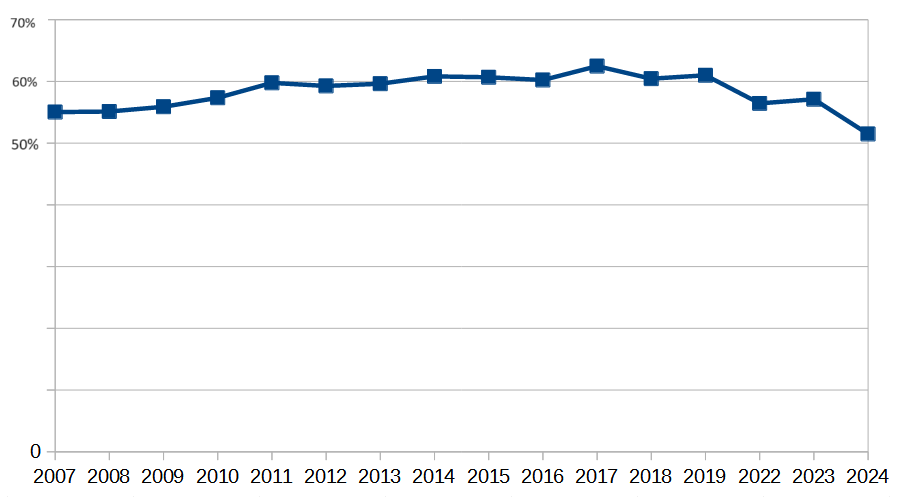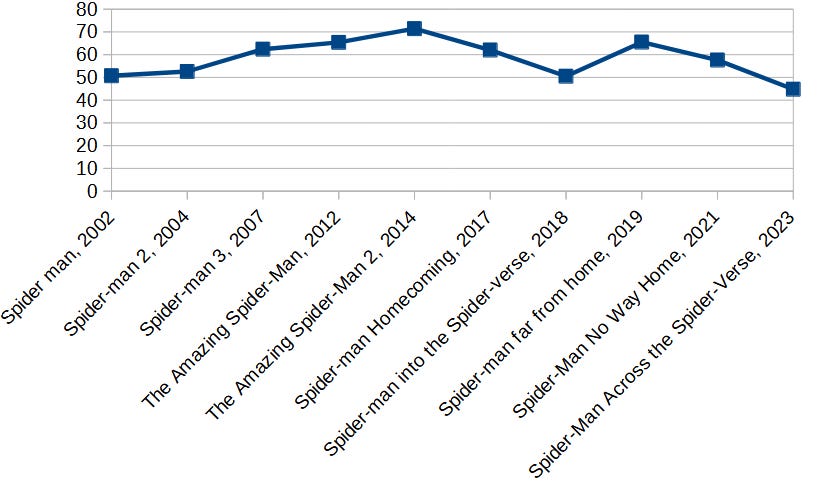American soft power is decreasing
A slow mo Hollywood story
The United States is considered a world power for a variety of reasons, including its military might and ability to project it around the world, its massive economic weight, and its significant soft power.
Soft power in this context means its ability to sway foreign elites and populations through the appeal of American culture, encompassing music, architecture, cuisine and film.
In this post I want to focus on the film industry and analyze recent trends on Hollywood’s global influence by examining box office figures for the past few years. My main question is whether Hollywood's influence on the rest of the world has changed over the past decade or so. Has it increased, decreased, or remained constant?
To accomplish this, I’ve calculated a ratio of international box office revenues for the 200 highest grossing films per year1, in comparison to domestic2 box office revenues for the same films.
The following chart shows the international to domestic box office revenue ratio for the years 2007 to 20243.
You can think of that ratio as the share of revenue that Hollywood derives from global markets, outside of North America, and as a proxy indicator of Hollywood’s cultural influence on the rest of the world.
You can see that up until 2017-2019, there’s a slight upward trend, reflecting the expected growth in a world where poverty has been decreasing and the share of the population able to afford a movie ticket has been rapidly increasing in most of the developing world. However, after 2019, the trend reversed and the ratio began to decline.
The previous ratio can also be expressed as a percentage, indicating the proportion of total revenues derived from markets outside the U.S. and Canada. The following chart shows this percentage for the years 2007 to 20244.

The trend is the same as above. Hollywood’s foreign revenue reached its peak in 2017 at 62%, subsequently declining to a low of 51% in the current year.
Correspondingly, the share of domestic revenue has gone up from approximately 38% to 49%. When considering the additional average revenue share of 9% that most movies obtain from other Anglosphere nations - the United Kingdom, Australia and New Zealand - that means an increase in the total Anglosphere revenue share from around 47% to approximately 58% during the same time period.
If these trends continue Hollywood's global influence may start to wane, potentially confining its impact primarily to the Anglosphere and a few other countries.
About car chases and monsters
To better understand these trends, it might be a good idea to take a look at what kinds of movies perform well outside the U.S. For this I’ve selected movies from the top 30 highest-grossing releases between 2015 and 20245, focusing on those that generated 72% or more of their revenue from international markets.
You can see from the previous list that some franchises enjoy significant popularity beyond the U.S., with the Fast & Furious series being particularly prominent. The Harry Potter and Transformers franchises also do well outside the U.S., albeit not to the same extent as Fast & Furious - both had one or two movies released in the 2015-2024 time period which didn’t make the cut.
From the point of view of genres, action, adventure, monster and children’s animation films seem to be well represented, with the monster genre being particularly successful. However, the superhero genre is not well represented.
This is striking given the superhero genre’s significant dominance in the box office throughout the years I’ve analyzed. Audiences outside the Anglosphere don’t seem to like superhero movies so much.
For now, I’ll refrain from delving deeper into the reasons behind the varying popularity of genres between the Anglosphere and other regions of the world. I’ll just say that if we assume these trends stem from cultural differences, it follows that the majority of the world will gravitate towards films that resonate with their cultures, rather than gradually converging towards American culture.
Have you ever seen a red and blue spider?
I recognize that this mild shift in trends might be attributed to a changing selection of movie offerings from Hollywood, rather than a change in the reception of Hollywood films by the wider world. Understandably, audiences desire variety and don’t want to watch the same movie over and over again. Hollywood responds to this desire by changing its offerings, which could consequently explain the changing reception of those movies by audiences.
To test if this could be a valid explanation, I decided to check whether there is any trend in international revenue for what I consider to be the closest approximation to a repeating movie: a franchise centered around a small set of characters6.
The following chart shows the proportion of revenues from markets outside the U.S. and Canada for the 10 movies in the Spider-Man franchise released between 2002 and now.

The highest percentage is observed in 2014 (The Amazing Spider-Man 2), close to the 2017 peak I identified for all of Hollywood, followed by a more pronounced declining trend than the one I uncovered previously.
This, provided it replicates for other American-oriented franchises7, makes me think that the trend is real, and not merely the result of a changing selection of Hollywood films being released.
Hollywood appears to be on a path of decreasing global influence, and with it, America may experience a slow but steady decline in its soft power.
I recognize that, given we are only in the fourth month of 2024, it might be premature to assert that this is a definitive trend rather than a temporary blip. I intend to revisit this subject in the future using more comprehensive 2024 data and check whether the supposed trend holds.
All figures come from Box Office Mojo. I limited this analysis to 200 movies to make it easier for me to calculate ratios and percentages.
I follow Box Office Mojo’s definition of domestic as encompassing the United States and Canada.
I didn’t include 2020 and 2021 because the the effect of Covid-19 on the film industry might have distorted the ratio. 2024 only to April 8.
To calculate this percentage only for Hollywood films, I employed a very simple heuristic. A film was classified as non-Hollywood if its revenue from outside the U.S. and Canada constituted 90% or more of its total revenue.
Excluding the years 2020 and 2021, and The Great Wall (2016) which I don’t consider a Hollywood movie.
I also examined the international revenue for the above mentioned Fast & Furious franchise from 2003 to 2023. It increases from a range of 50%-60% in the early years to around 80% in the most recent installments. This sheds light on a possible contributing factor to the trends I’ve mentioned, but I’d rather keep this post concise and maybe delve further into this factor in a future post.
The Hunger Games franchise, being very U.S-centric and having releases throughout the relevant years, might be a good candidate.




I think part of this is just Hollywood being out of nostalgia to milk. It’s hard to think of a tv, film, or comic that hasn’t got a film version or a reboot in the last 30 or so years. This is why Hollywood is now turning to toys and video games for content, it’s the last thing with widespread cultural relevance left.
Take a look at how that new Ghostbusters movie is doing. That film and its predecessor were absolutely begging for a younger audience to watch it yet the new one is bombing. Zoomers and gen alpha do not care about a franchise that grandpa liked 40 years ago. This is doubly true for many foreign markets where those properties were either never popular or never released, like Star Wars in China. Add to that the very American woke angle, and you get films audiences outside the US either cant relate to or outright reject.
Fascinating analysis. Thank you!